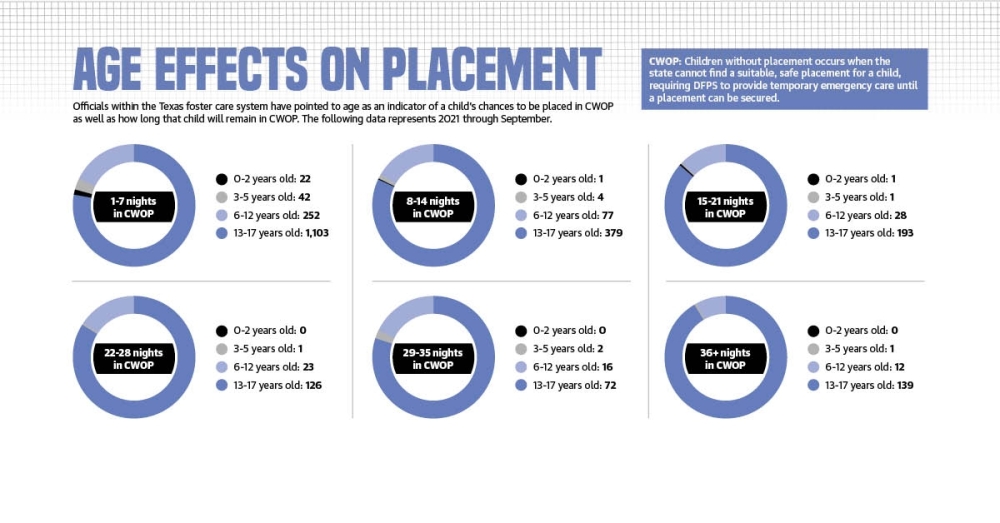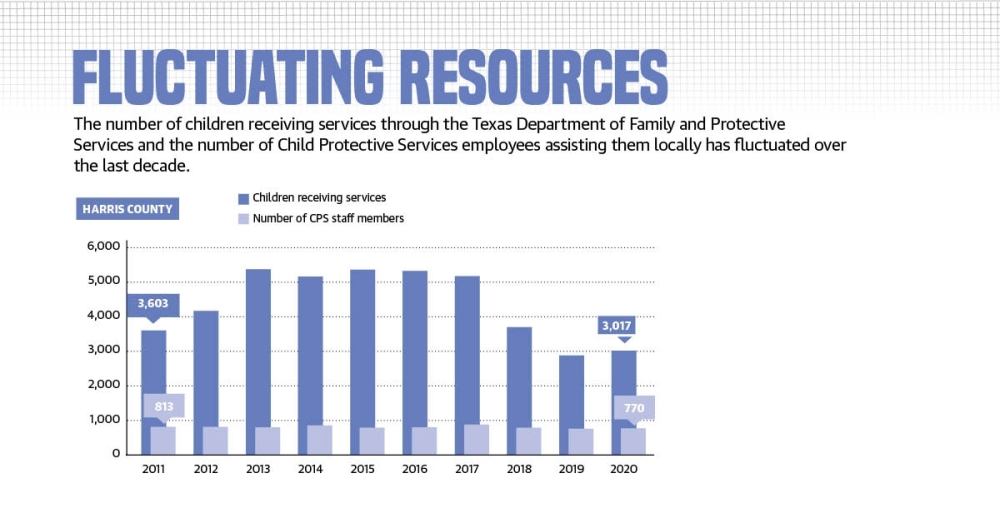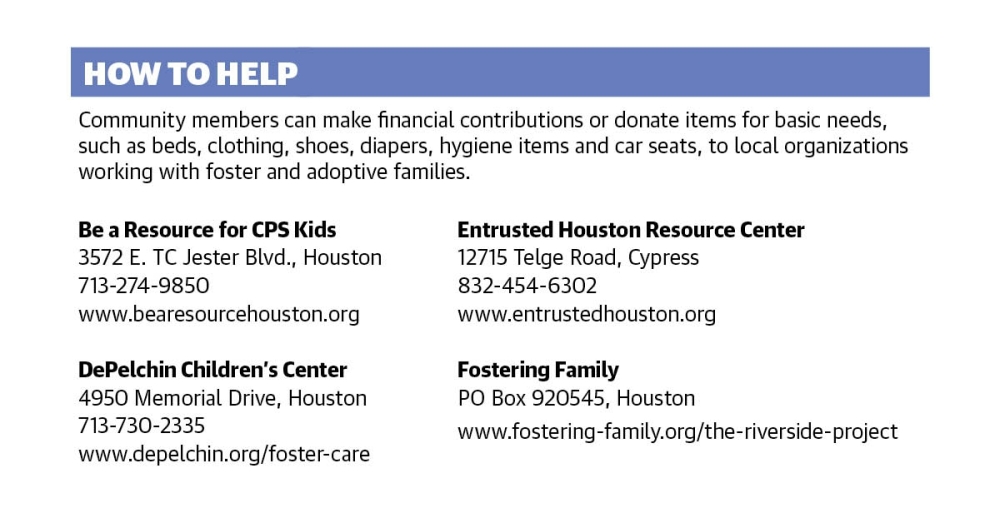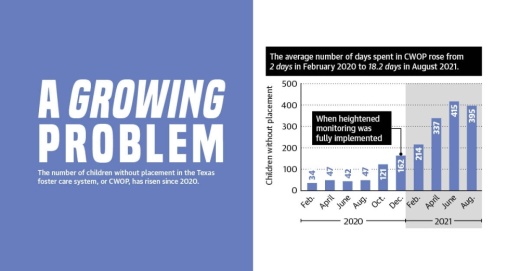According to DFPS officials, individuals in the state’s foster care system receive a “child without placement” designation, or CWOP, when the state cannot find a suitable and safe placement for that child, requiring the DFPS to provide temporary emergency care until a placement can be secured.
Over the last two years, the state has increasingly relied on placing children in unlicensed placements—often motels or office buildings—overseen by caseworkers. In October 2019, 32 children were in such placements statewide, according to DFPS data. By August 2021, that number had risen to 395 children. Entrusted Houston is a Cypress-based nonprofit that supports the DFPS in its goal of family reunification.
“We are definitely trying to handle the crisis that is the CWOP, and the caseworkers, the supervisors—they’re trying to do everything they possibly can,” said Lisa Johnson, Entrusted Houston executive director and a longtime foster parent. “The pandemic has burned them out. Just like in every field out there, people are retiring early; people have left their positions on every level of [Child Protective Services].”
In Harris County, the number of CWOP has also trended upward over the last year. In September 2020, two of the 1,635 children receiving DFPS services were placed in CWOP. By September of this year, eight of the 1,415 children receiving services had been placed in CWOP.
DFPS officials have attributed the increase to challenges associated with the ongoing coronavirus pandemic as well as caseworker turnover and recently enforced regulations.

Extenuating circumstances
In an August CWOP report, DFPS officials said the number of children in CWOP had risen, in part, because of heightened monitoring regulations mandated after U.S. District Judge Janis Graham Jack ruled in 2015 that foster children in Texas “almost uniformly leave state custody more damaged than when they entered.”
The lawsuit alleged youth in the foster care system were often bounced between homes, had too little contact with overworked caseworkers, and were not sufficiently protected from physical and sexual abuse.
Resulting system reforms included heightened monitoring, which is implemented when certain foster care system entities have had a high rate of standard and contract violations.
Entities placed under heightened monitoring are given a remedial plan by court monitors to address deficiencies and are subject to weekly unannounced visits to ensure they are complying. Operations that fail to address the issues within a year can have their licenses revoked, placements suspended, contracts terminated or can incur fines.
Since the beginning of 2020, 21 general residential operations—facilities housing 13 or more children—have been shut down or had their licenses revoked statewide, resulting in the loss of roughly 1,200 beds, according to a court monitor update issued in September.
Moreover, several entities facing heightened monitoring voluntarily closed during that time frame, resulting in the additional loss of 375 beds and 157 verified foster homes statewide. According to Rebecca Mercer, regional director of statewide adoption agency Lonestar Social Services, heightened monitoring has also led to some foster parents removing themselves from the system altogether.
“[Heightened monitoring has] forced us to enforce stricter rules on our foster parents, and they have definitely felt the heat from that, which, in turn, turns foster parents away because it’s just too stressful,” Mercer said.
Still, Mercer said she understood why the restrictions have been imposed. “We’re trying to weed out those parents who may not have the best interests for the child because there are some out there,” Mercer said.
Additionally, Mercer said difficulties arising from the COVID-19 pandemic have made finding suitable placements for children more difficult.
“We’ve had a lot of foster parents that will come to us and say, ‘Until COVID is over, we’re not interested in taking placements anymore because it’s just too much,’” she said.
Searching for solutions
The DFPS has identified a need for 669 additional beds throughout the state to meet growing demands on the welfare system. Additionally, the department said it is lacking an adequate number of CPS caseworkers with 236 vacancies statewide.
State Senate Bill 1896, which passed in May, revised and added regulations for the DFPS, including forbidding the department from housing a child in an office overnight and fully transitioning into electronic case management.

The DFPS requested an additional $83.1 million as part of SB 1 to hire 312 caseworkers, which the Legislature fully funded. House Bill 5 passed in September and allotted another $90 million to the DFPS to retain providers and increase capacity to serve foster youth.
“[This funding] is the difference between a real placement for these older children and continuing to live in a CPS office or hotel,” said Melissa Lanford, the media specialist for DFPS Region 6.
In the September report, DFPS Commissioner Jaime Masters said many providers have cited heightened monitoring as a reason for declining a placement, although she noted that did not indicate a disapproval of the mandate.
“DFPS is not ‘blaming’ the CWOP crisis on the court’s heightened monitoring orders,” Masters said in the report. “While the monitors have noted DFPS’ ‘collaborative’ efforts of listening to concerns of its stakeholders, it is an undisputed fact that DFPS cannot do this alone.”
Masters said caseworker turnover resulting from overworked employees has contributed to the growing number of CWOP. Between February and July, the DFPS hired 319 caseworkers, but 309 caseworkers terminated their employment during that time. According to 2021 exit surveys, 86% cited work-related stress as a reason for terminating their employment, up from 40% in 2020.
Despite the additional staff members, Masters said the average number of hours each employee spent supervising CWOP increased from 22.5 hours in December 2020 to 35.7 hours in July.
In Harris County, the number of children receiving DFPS services rose by 141 from 2019 to 2020, while the number of staff members fell by 14, according to DFPS data.
In October, Gov. Greg Abbott approved the creation of a new expert panel to analyze the rising number of foster care children in CWOP. The three-person panel will issue recommendations to the governor’s office by mid-December.
Tammy Hetmaniak, executive director of Be a Resource, or BEAR, for CPS Kids, encouraged donating items such as clothing and food to support children in CWOP.
“It’s important that we can make [children in CWOP] as stable as we possibly can, so when our contacts with the DFPS ask us for a resource for these children, we work to make sure that happens,” she said.








